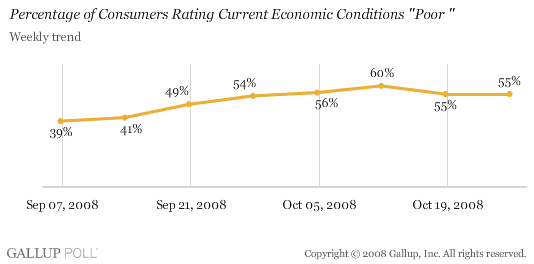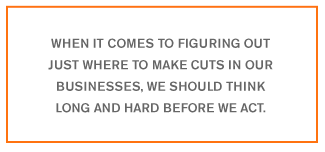It's been a scary few weeks for businesses and consumers, and things could remain unnervingly uncertain for quite some time. Markets around the world are down significantly, and stock prices remain volatile. The credit markets are constrained. Home values continue to slide, while foreclosures are on the rise.
And there probably won't be relief any time soon. A majority of Americans see current economic conditions as poor, and almost 9 out of 10 think things will continue to deteriorate. What's worse, more than half of all Americans report they are struggling, according to the Gallup-Healthways well-being measure. None of this is good news. (See graphic "Percentage of Consumers Rating Current Economic Conditions 'Poor.'")

In times of economic turbulence, businesses and consumers need to tighten their belts. But with belt tightening, as with most things, the devil is in the details. With our family budgets, for example, we might start by forgoing that dinner out, skipping the movie in favor of renting a DVD, putting off that family vacation, or turning down the thermostat a couple of notches. After making the obvious cuts, though, the choices become much more difficult.
When it comes to figuring out just where to make cuts in our businesses, we should also think long and hard before we act. For companies trying to adjust to a new economic reality, where to cut rarely involves obvious and easy choices. For instance, market research, organizational development, and human resources -- functional areas that often own a company's customer and employee measurement budgets as well as its leadership and succession-planning activities -- are often easy initial targets for cost-cutting efforts. But shutting down these crucial listening posts and people-management processes may mean that your company is doing away with information that could be key to its survival -- and instead, is trusting in luck.
Key questions
We hear it all too often: "Our business needs to cut somewhere, and this is as good a place as any. We'll start these programs back up when things get a little closer to normal." But applying scientific discipline to your company's hiring and succession-planning processes and monitoring the health of your customer and employee relationships are no longer "nice to have" items. In today's business environment, and particularly in times of uncertainty, they are absolutely essential. Why? Well, ask yourself these questions:
Do we have the people we need to lead us through tough economic times? Disciplined selection processes and carefully validated succession planning can help ensure that you have the right people on your team to start with. But equally important, these systems can make sure that the people on the team are in the right roles. If you make sure that the right leaders and managers are in place, then it's much more likely that your company will be able to formulate and execute its survival strategy.
Reducing headcount usually involves an organizational realignment. When deciding who must go -- and why -- it's important to retain not only the best leadership talent but the right blend of talent for the realigned organization. Maintaining your company's best talent during downturns is essential, and a disciplined, fact-based selection and succession-planning methodology can help you identify and retain the best leaders for specific roles, situations, and teams. Companies that have an appropriate methodology for selecting and retaining talent can ensure that organizational realignment and downsizing won't threaten the effectiveness of the revised leadership structure.
Can our employees do more with less? A focus on employee engagement is essential to answering this question. During tough times, your staff will be expected to work longer hours and take on more work while doing without the bonus checks they used to count on. All of these things will exact a psychological and physical toll; employee well-being and health may suffer. Keeping your staff emotionally connected to the company is essential.

Engaged employees not only will help your company deliver superior organizational performance, but their engagement will also help insulate them from the debilitating consequences of increased stress. Compared to their disengaged counterparts, engaged workgroups are more productive and profitable and deliver superior customer outcomes. Engaged employees are more innovative. Great companies see tough economic times as an opportunity to double down on their investment in people and in research and development. In contrast, a cost-cutting mentality actually tends to shut down creativity and ill equips a company for future growth.
Because your engaged staff members will enable your company to do more with less, it becomes even more crucial to retain and develop your best people when your company must operate with fewer people. More importantly, Gallup research suggests that companies that engage their employees grow earnings at a rate that is 2.6 times faster than companies that do not. During an economic downturn, these same companies can be expected to hold their own much more effectively against poor conditions. (See "Investors, Take Note: Engagement Boosts Earnings" in the "See Also" area on this page.)
Are we reducing costs in a way that won't have unintended consequences down the road? Engaged workgroups have significantly better staff retention, lower absenteeism, fewer accidents, and yield lower levels of "shrink" (for example, theft or breakage) than disengaged workgroups. These kinds of cost reductions not only yield greater operating efficiencies but also accrue benefits to your company's bottom line. Gallup's most recent meta-analysis revealed that compared to the least engaged workgroups in a company, the most engaged workgroups have 62% fewer accidents, 51% less theft and breakage, 51% lower turnover (for low-turnover firms), and 27% lower absenteeism.
Are we guaranteeing that our brand will remain healthy? Engaged employees are stronger "ambassadors" for your brand, carrying a more consistently aligned and compelling brand message into the marketplace to existing customers and prospects. For example, in a recent Gallup Poll on the topic, 81% of engaged employees strongly agreed that they knew what their company stands for and what makes them different, while just 11% of actively disengaged employees felt the same way.
Are we caring for our most precious asset -- our customers -- in a way that is sustainable? Engaged customers represent a significantly better value proposition to the company than disengaged customers. Highly engaged customers represent, on average, a 23% premium in terms of share of wallet, profitability, revenue, and relationship growth than the average customer, while disengaged customers represent a 13% discount.
What's more, research that Gallup conducted after September 11, 2001 revealed that companies that maintained a higher level of engagement among their customers were more resistant to economic stresses than companies that had lower levels of customer engagement. Specifically, companies with high levels of customer engagement suffered significantly smaller stock declines when the markets reopened on September 17 than did companies with less engaged customer relationships. (See "Stress Resistant Customer Relationships" in the "See Also" area on this page.)
Are we preparing to emerge on the other side of the downturn stronger and more competitive than ever? Effectively measuring and managing these key human business dimensions will leave your company better prepared to accelerate performance when the skies brighten.
You would never drive with your headlights off as you enter a dark tunnel or take your hands off the wheel as you begin to negotiate winding mountain roads. That's just way too risky. So why would your company do the equivalent when faced with tough economic times? Ensuring that your staff, leaders, and managers are carefully selected and positioned; your staff is engaged; and your customers are emotionally connected to your company helps provide a strong foundation for surviving -- and maybe even thriving -- in this turbulent and uncertain market.
